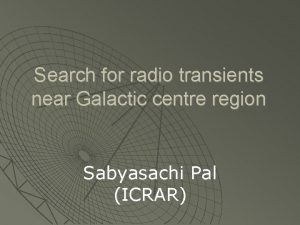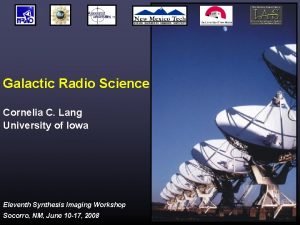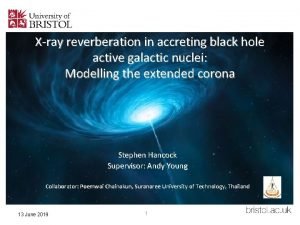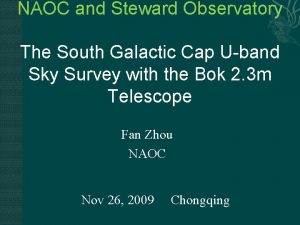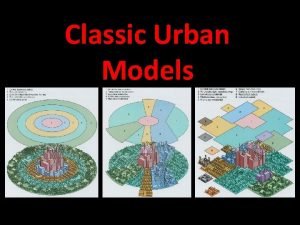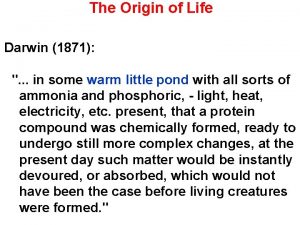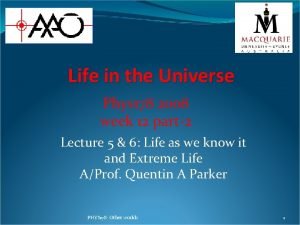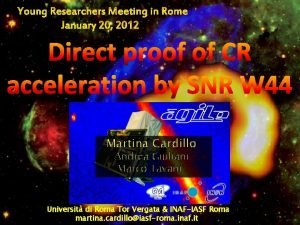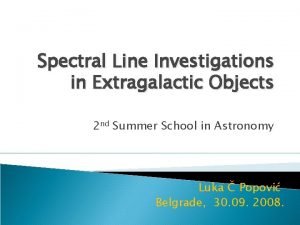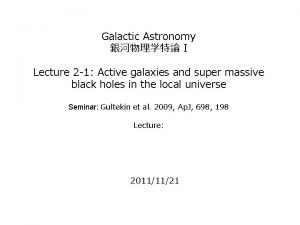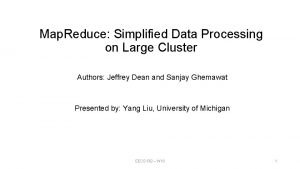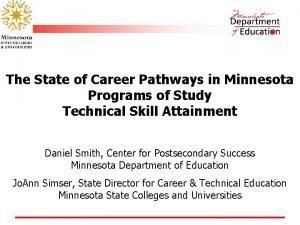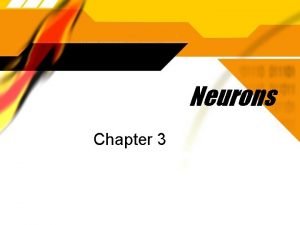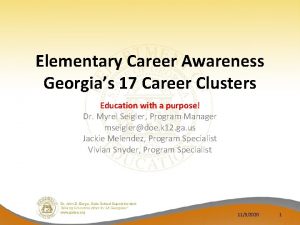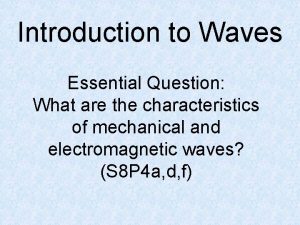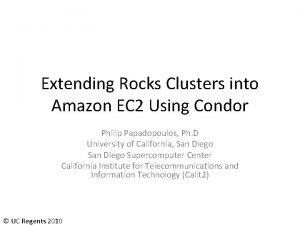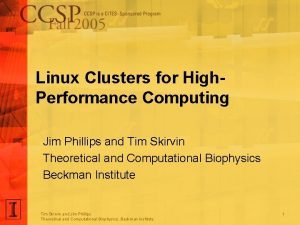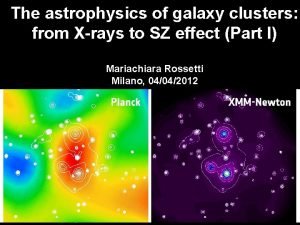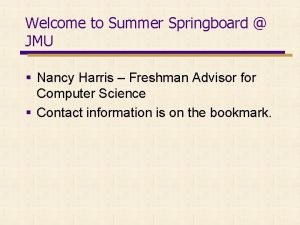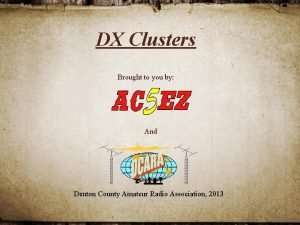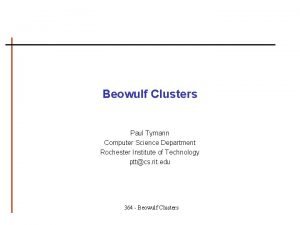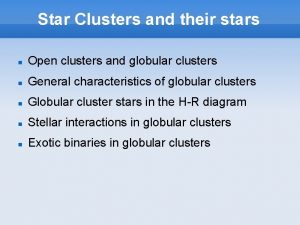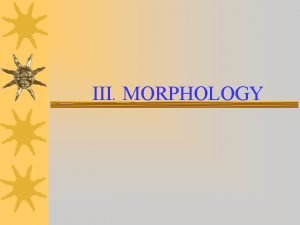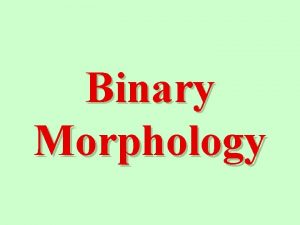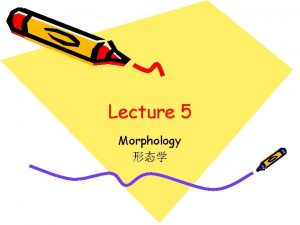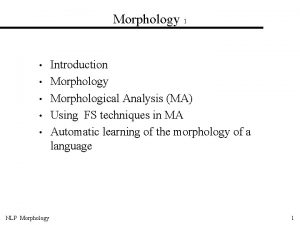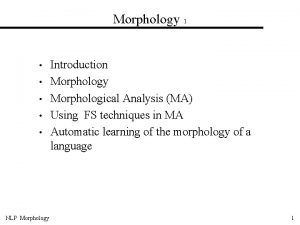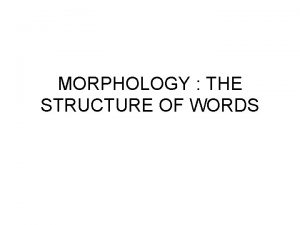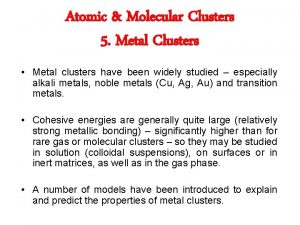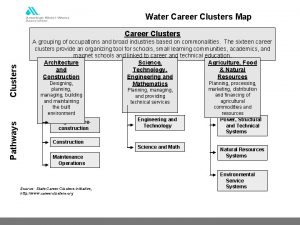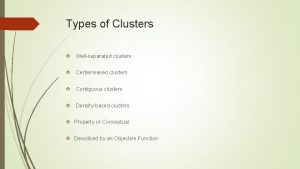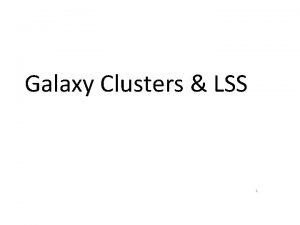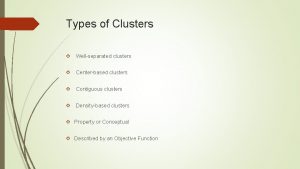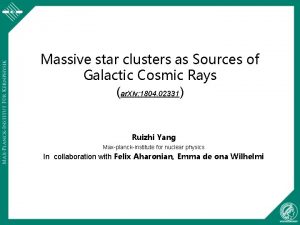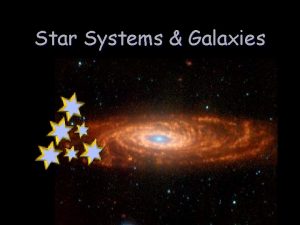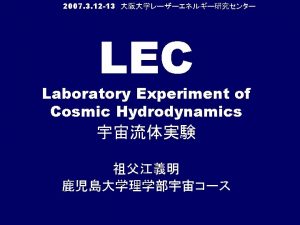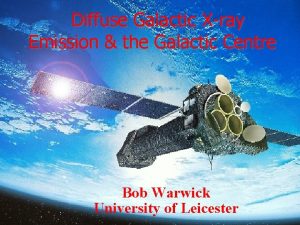Morphology of Galactic Open Star Clusters W P















































- Slides: 47

Morphology of Galactic Open Star Clusters W. P. Chen (陳文屏) Graduate Institute of Astronomy |and Department of Physics National Central University Colloquium National Tsing Hua University 2003. 28 NTHU Colloquium

What we learn/teach in AST 101… NTHU Colloquium 2

Globular Clusters They are --ü large collections of stars --- 105 to 106 stars ü spherically shaped and centrally concentrated ü composed of old stars with little ‘metals’ ü located in the halo around the Galaxy Shakedown image of M 15 with Lulin 1 m 2002. 09/10 NTHU Colloquium 3

NTHU Colloquium 4 M 104 with LOT 2003. 03

Open Clusters They are ü irregularly shaped and sparse ü small groupings of stars --- 102 to 103 stars ü composed mostly young stars with abundant ‘metals’ ü located in the Galactic disk Just how irregular are they anyway? NTHU Colloquium 5

Star clusters are good astrophysical laboratories because they contain stars of different masses q of the same age q at the same distance q with the same composition Most stars probably were formed in a clustered environment Cluster Formation = Star Formation NTHU Colloquium Chandra image of the Trapezium 6

Globular Clusters Stars concentrate progressively toward the center. The King model (1962) is understood as a combination of an isothermal sphere; i. e. , dynamically relaxed in the inner part of the cluster, and tidal truncation by the Milky Way in the outer part. NTHU Colloquium Surface brightness of M 3 (Da Costa and Freeman, 1976) 7

King Model (1962) rc: core radius rt: tidal radius k central number density NTHU Colloquium 8

Structure of Open Clusters • The initial stellar distribution in a star cluster is dictated perhaps by the structure in the parental molecular cloud. (Initial) • As the cluster evolves, the distribution is modified by gravitational interaction among member stars. (Internal) • Eventually stellar evaporation and external disturbances --- Galactic tidal force, differential rotation, and collision with molecular clouds --would dissolve the cluster. (External) NTHU Colloquium 9

Questions to address … • How would an open cluster shape out of the molecular cloud from which it is formed? • How would it organize itself by internal gravitational interaction, and by external disturbances? • To what extent the Galactic potential influences the morphology of an star cluster? NTHU Colloquium 10

Spatial Structure by Star Counting in 2 MASS • Stellar density within concentric annuli • Center too crowded to resolve by 2 MASS; outer part follows well a King model • Background uniform out to large angular extents • Klim (3 - )=15. 6 --- not deep enough to reach MS, for distant Projected radial stellar and old globular clusters density of a GC, M 55 NTHU Colloquium 11

2 MASS has uniformly scanned the entire sky in three nearinfrared bands to detect and characterize point sources brighter than about 1 m. Jy in each band, with signal-to-noise ratio greater than 10, using a pixel size of 2. 0". This has achieved an 80, 000 fold improvement in sensitivity relative to earlier surveys. 2 MASS used two highly-automated 1. 3 -m telescopes, one at Mt. Hopkins, AZ, and one at CTIO, Chile. Each telescope was equipped with a three-channel camera, each channel consisting of a 256× 256 array of Hg. Cd. Te detectors, capable of observing the sky simultaneously at J (1. 25 microns), H (1. 65 microns), and Ks (2. 17 microns), with 10 -sigma limit of 15. 8 (J), 15. 1 (H), 14. 3 (K) mag. 2 MASS All-Sky Data Release 2003 Mar 25!

Map of the 2 MASS Point Source Catalog (~471 M sources) integrated flux in 5 × 5´ NTHU bins. Colloquium in a galactic Aitoff projection 13

Optical (left) and near-infrared (right) image of IC 348, an embedded star cluster NTHU Colloquium 14

2 MASS 3 -sigma limit NTHU Colloquium 15

IC 348 by 2 MASS Open cluster NGC 2506 (1. 9 Gyr; 3. 3 kpc) mosaiced from 2 MASS data NTHU Colloquium 16

Sources toward NGC 2506 and the surface density NTHU Colloquium 17

NTHU Colloquium 18

Locations of sample galactic open clusters. http: //www. ipac. caltech. edu/2 mass/ NTHU Colloquium 19

Radial density profile of NGC 2506 NTHU Colloquium 20

Cumulative stellar density profiles for NGC 2506 (1. 9 Gyr; 3. 3 kpc) shows apparent evidence of mass segregation NTHU Colloquium …… in contrast to that in M 11 found by Mathieu (1984) 21

Stars in the young (5 Myr) star cluster IC 348 are centrally concentrated, and seem to segregate star formation processes more than subsequent dynamic evolution NTHU Colloquium 22

The old (9 Gyr) open cluster Berkeley 17 shows no evidence of mass segregation. NTHU Colloquium 23

Cluster l, b (Myr ) N* M/M⊙ D (kpc) Rs (‘) R (pc) re (Myr ) τ/τ re Segr. Young NGC 1893 174, -02 4 498 309 4. 4 6. 5 8. 9 291 0. 01 ? IC 348 160, -18 5 322 200 0. 32 16. 5 1. 6 14 0. 2 Y Intermediate NGC 1817 186, -13 800 236 146 2. 1 12. 5 7. 9 139 6 N? NGC 2506 231, +10 1, 900 1, 038 643 3. 3 17. 5 17. 3 605 3 Y NGC 2420 198, +20 2, 200 450 279 2. 5 12. 5 9. 4 223 10 Y Old NGC 6791 070, +11 8, 000 1, 095 679 4. 2 10. 5 13. 2 543 15 ? Be 17 176, -04 9, 000 370 229 2. 5 9. 5 7. 1 142 63 N NTHU Colloquium 24

Relaxation Time τcross = R/V ; τrelax ~τcross.Ncross = 0. 1 N / ln N τevap ~ 100 τrelax R: radius V: velocity dispersion N: number of member stars NTHU Colloquium 25

NGC 1893 --- 4 Myr NTHU Colloquium 26

IC 348 --- 5 Myr NTHU Colloquium 27

NGC 1817 --- 800 Myr NTHU Colloquium 28

NGC 6791 --- 8, 000 Myr NTHU Colloquium 29

Be 17 --- 9, 000 Myr NTHU Colloquium 30

Summary • 2 MASS good for study of open clusters • Stars in an open cluster, regardless of masses, are concentrated progressively toward the center. • The youngest star clusters show evidence of luminosity (mass) segregation, a relic of the parental molecular cloud structure (SMA) • By a few Gyr (several relaxation times), clusters become highly relaxed, until dynamical disruptions dominate the structure. NTHU Colloquium 31

Our knowledge, or even recognition, of galactic open clusters is highly incomplete, most biased toward the ones that are nearby and with bright stars. NTHU Colloquium 32

Open clusters are distributed widely around the galactic disk. NTHU Colloquium 33

• Studying star clusters, and knowing their origin(s), properties, etc. , are fun …. . But • They are good tools, too. They are gravitating systems. They emit light (easy to trace). Good test particles in Galactic gravitational potential Good tracers of Galactic star formation history and chemical evolution NTHU Colloquium 34

• Dias (2002): a new catalogue of Galactic open clusters which updates the previous catalogues of Lynga (1987) and of Mermilliod (1995). • Virtually all the clusters (1607) presently known were included, an increment of 456 objects relative to the Lynga (1987) catalogue. • In total, 99% with known apparent diameters 38% with distance, E(B-V) and age determinations 6% with abundance data 9% with proper motion and radial velocity data NTHU Colloquium 35

Sample still vastly incomplete; more star clusters away from the Galactic center Selection effects? Dynamic effects? e. g. , disintegration by encounters with GMCs in the inner part of the Milky Way? Chen et al. astro-ph 0212542 e. g. , only the most robust survived and lasted? NTHU Colloquium 36

A possible connection between the halo and disk populations? Chen et al. on Dias catalog; c. f. Ojha et al (1996): thin disk~260 pc; NTHU Colloquium thick disk~760 pc 37

How do old star clusters survive in the disk from tidal disruption and differential rotation? Chen et al. on Dias catalog c. f. Phelps (1994) z~55 pc for young and 375 pc for old clusters NTHU Colloquium 38

NGC 1893 Surface star density NGC 1931 NTHU Colloquium NGC 2420 39

Eccentricity vs. z of 36 open clusters in our sample. Eccentricity vs. Age of our sample clusters. NTHU Colloquium 40

Conclusions … for now • Most open clusters are elongated. • The higher z an open cluster locates, the more circular it is influence of the Galactic disk on the morphology of a star cluster. • Cluster internal dynamics spherical/circular • By 100 Myr, internal relaxation competes with external influence (e. g. , Galactic tidal force, differential rotation) in shaping a star cluster. • The oldest and most eccentric star clusters in the process of disintegration? NTHU Colloquium 41

NGC 2395 l, b: 204. 6052, +13. 9879 Heliocentric distance: 512 pc Age: 109. 07 z: 124 pc Going…and going… More than 200 star clusters being analyzed …. NTHU Colloquium 42

Be 17 Density (distribution) of neighbors Pstar, i= (Nobs – Nbg)/Nobs within an angular range D = Pi NTHU Colloquium 43

Open Cluster Study at NCU • Luminosity Function Evolution age and star formation history (e. g. , coeval vs periodic bursts) done • Structural Evolution dynamics probing galactic mass distribution (e. g. , disk vs volume potential) 2/3 done • Variability and [rotation vs magnetic activity] doing NTHU Colloquium 44

Open Clusters/NCU --- cont. • Lulin 1 m telescope (Taiwan) September 2002 • Maidanak Observatory (Uzbekistan) 1. 5 m and 1 m 1/3 time on 1 m • Moletai Obs. 1. 65 m (Lithuania) Coravel • YALO 1 m (Chile) • Kentucky-Yunnan-Taiwan Telescope (KYTT) to lift off by 2004 -2005? NTHU Colloquium 45

Fast rotating stars P(rot) < 12 d (BLUE) are distinguished from slow rotators (RED) by their X-ray luminosity (normalized to solar – in yellow. The Rossby number gives the rotation period in units of the eddy's lifetime. NTHU Colloquium 46 (http: //www. aip. de/groups/turbulence/star_t. html)

NTHU Colloquium 47
 Bearing gifts we traverse afar
Bearing gifts we traverse afar What is inflectional and derivational morphology
What is inflectional and derivational morphology 영국 beis
영국 beis Galactic centre radio transients
Galactic centre radio transients Galactic phonics ure
Galactic phonics ure Star wars combine
Star wars combine Galactic
Galactic Active galactic nuclei
Active galactic nuclei Galactic cap review
Galactic cap review Galactic city model
Galactic city model Galactic habitable zone
Galactic habitable zone Galactic address
Galactic address Galactic habitable zone
Galactic habitable zone Alessandro cardillo
Alessandro cardillo Harris peripheral model
Harris peripheral model Active galactic nuclei
Active galactic nuclei Multiple nuclei model example
Multiple nuclei model example Active galactic nuclei
Active galactic nuclei Compare a* and ao* algorithm
Compare a* and ao* algorithm What does star (for star events) stand for?
What does star (for star events) stand for? Velocitation means
Velocitation means Cue clusters in nursing
Cue clusters in nursing Sanjay ghemawat
Sanjay ghemawat Mn career clusters
Mn career clusters Two almond shaped neural clusters
Two almond shaped neural clusters Enrichment clusters
Enrichment clusters Georgia career clusters
Georgia career clusters Types of waves quad clusters answer key
Types of waves quad clusters answer key Career cluster definition
Career cluster definition Are clusters of measurable ksas
Are clusters of measurable ksas Galaxy clusters
Galaxy clusters Gram positive grape like clusters
Gram positive grape like clusters Cluster c
Cluster c 16 career cluster
16 career cluster Define career cluster
Define career cluster Vowel clusters examples
Vowel clusters examples Rocks cluster tutorial
Rocks cluster tutorial High performance computing cluster linux
High performance computing cluster linux Galaxy clusters
Galaxy clusters Mapreduce simplified data processing on large clusters
Mapreduce simplified data processing on large clusters Jmu nursing course planning worksheet
Jmu nursing course planning worksheet F5len web cluster
F5len web cluster Rit cs clusters
Rit cs clusters Virtualization of clusters in cloud computing
Virtualization of clusters in cloud computing Virginia career clusters
Virginia career clusters Danielson clusters
Danielson clusters Mn career clusters
Mn career clusters Model of grand strategy clusters
Model of grand strategy clusters



